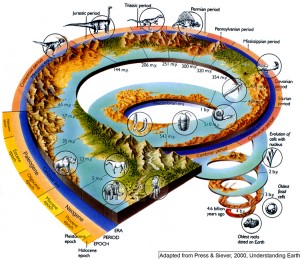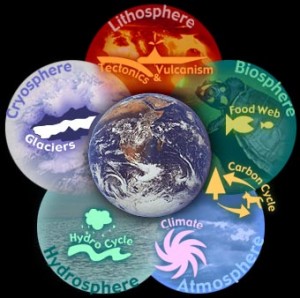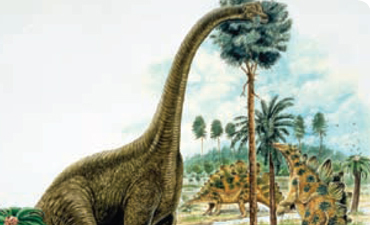One of the great questions that Palaeontology poses is how did life and the Earth co-evolve together? This is especially so in the case of early life during the Phanerozoic period (540 million years ago until now), when complex multi-cellular life took off and ultimately came to dominate the planet. When one considers the vast number of potential factors involved in this, it can be pretty overwhelming. To start off with, you have organisms themselves which adapt through altering their physical appearance and functionality. Driving this, you have the environment and the ecosystems in which organisms dwell. How many parameters can you think off that may have some effect, any effect, on the life of an organism or population of organisms, that could have some impact on evolutionary trajectory? There’s a lot, right? Some of the major environmental factors include oxygen and carbon dioxide concentrations, nitrogen, temperature, humidity. You can find variations of almost any environmental variable nowadays, and correspond it to variability in the local biota. But what about during the Phanerozoic? How much can we still see left preserving this great orchestra of ever-changing life and planet?

The complex spiral of life on Earth. But what about the fine points of co-evolutionary history? Source: Astrobioblog (click for larger image)
540 million years is a long time. Duh. Picture the totality of life over this time as an immense book. Without the fossil record, all we’d have is the last few sentences on the last page of this, probably with a picture of Justin Bieber as the epitome of modern life. The rest of the book would be empty without fossils, and the history of life on Earth would be pretty pathetic. With the fossil record, what we get instead are words scattered here and there, and rarely complete sentences, that we can piece together like a jigsaw puzzle, except with most of the pieces missing and no image to guide us. Occasionally we also see a faded picture in the book, giving us a fleeting glimpse through the portals of time, and into a world that life has long forgotten about.
Imagine now we have a second book. Each page, each sentence, each word corresponds in time with it’s position in the first book, providing a parallel series not of fossils, but an account of what the non-biological geological record tells us. These can be anything, from ancient lake sediments, huge basins stuffed full of ancient foraminifera, to apocalyptic-scale volcanic provinces. It’s a pretty detailed book, considerably more so than the first. What it provides us with is the imperfect fingerprint for what Earth as a whole, including the geosphere, biosphere, hydrosphere, chemosphere, every type of Earth system you can think of, used to be like.

The five major Earth systems. Ice, water, earth, air, and..fish. Source.
The truly magical science happens though when you fuse these two books. Imagine overlaying the pages so that they match each other through time. In some places, we are devoid of information entirely; there are no words. Others, we might have a lonesome series of fossils, or perhaps some sedimentary sequence that tells us how humid the Earth was in South Africa 150 million years ago. It could be anything. In some places, what we will find, and will see as our knowledge of the geological and fossil records intensifies, is an overlap. It’s in these places where we can start drawing correlations, and where we see the exquisite history of life unravel, and the ethereal nature of evolution become reality. With pieces of the story bound together, and becoming so more frequently, trends can become apparent, and eventually patterns of co-evolution that once were just figments of a geologist’s or palaeontologist’s imagination. We’re getting there. Every new fossil we find, every chemical analysis, every isotopic record, every rock that we can draw information from is filling this great compendium of Earth’s intricately coupled history.

A current hot topic of debate is whether dinosaurs drove the evolution of plants during the Mesozoic, or vice versa. In terms of diversity patterns, this is a question of co-radiation. When you look at if functionally, you begin digging into co-evolutionary theory. Source: Natural History Museum
One tiny page of this great volume is what I’m beginning to research, and hopefully, as I travel back to this time, I can tell you all about what a magnificent journey it will be. Hey, that’s science! Note that co-evolution also happens in a purely biological sense, for example between the busy little bee and the flowers in your back garden. This is a much more delicate dance, and one that is not often preserved in the fossil record. What we see are ocassional glimpses of this, as part of a much grander scale of the history of life on Earth.
